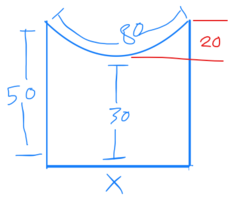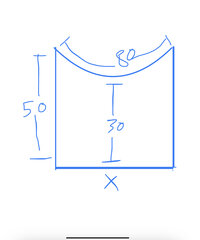This problem has caused some trouble to say the least in my workplace. I’m more trying to figure yes the answer but also how could one arrive at the answer. My thought initially is that it has to be less than 80 because the “rope” at the top decreases in distance as it’s squished. The original picture perceived the main part of it to be a rectangle as well so I think as of now my thought is it must be greater than 50 less than 80.
Solving for bottom x, top line dimension defined but is a slope.
- Thread starter Devonkgg
- Start date
- Joined
- Feb 4, 2004
- Messages
- 16,582
I'm sorry, but I don't understand what you're asking...? What do you mean by the "top line" (the curve on the top side of the figure?) is "defined by is a slope"?This problem has caused some trouble to say the least in my workplace. I’m more trying to figure yes the answer but also how could one arrive at the answer. My thought initially is that it has to be less than 80 because the “rope” at the top decreases in distance as it’s squished. The original picture perceived the main part of it to be a rectangle as well so I think as of now my thought is it must be greater than 50 less than 80.
What is causing you not to be able to measure the width of the figure, just as you measured the height and the length of the rope?
What other information have you been given, that would allow for the possibility of finding the width x? (With only the posted information, the value for x could obviously be anything less than 80 but greater than zero.)
When you reply, please include a clear listing of your thoughts and efforts so far, as this can help us understand what is going on. Thank you!
Dr.Peterson
Elite Member
- Joined
- Nov 12, 2017
- Messages
- 16,814
I think you are asking how to find the horizontal distance x between two points when a catenary of a known length 80 units between them dips 20 units at its midpoint.This problem has caused some trouble to say the least in my workplace. I’m more trying to figure yes the answer but also how could one arrive at the answer. My thought initially is that it has to be less than 80 because the “rope” at the top decreases in distance as it’s squished. The original picture perceived the main part of it to be a rectangle as well so I think as of now my thought is it must be greater than 50 less than 80.
Certainly it will be less than 80 units. I tried looking for a site with a quick formula or calculator for you, but they generally take the width as given. The appropriate formulas can be found in the Wikipedia page; I haven't taken the time to solve for what you want.
- Joined
- Feb 4, 2004
- Messages
- 16,582
Devonkgg: Why do you think that x must be greater than 50? Even if the two sides were touching each other, the rope in between would only go 40 units down the sides (before going back up to the other endpoint)....my thought is it must be greater than 50 less than 80.
Dr.Peterson: Where are you getting the 20-unit dip? Is that an estimate from the picture?...find the horizontal distance x between two points when a catenary of a known length 80 units between them dips 20 units at its midpoint.
Dr.Peterson
Elite Member
- Joined
- Nov 12, 2017
- Messages
- 16,814
50 - 30 = 20:Devonkgg: Why do you think that x must be greater than 50? Even if the two sides were touching each other, the rope in between would only go 40 units down the sides (before going back up to the other endpoint).
Dr.Peterson: Where are you getting the 20-unit dip? Is that an estimate from the picture?

Dr.Peterson
Elite Member
- Joined
- Nov 12, 2017
- Messages
- 16,814
When I got back to look at details, I found that the formulas there are more exactly what you need than I expected.I think you are asking how to find the horizontal distance x between two points when a catenary of a known length 80 units between them dips 20 units at its midpoint.
Certainly it will be less than 80 units. I tried looking for a site with a quick formula or calculator for you, but they generally take the width as given. The appropriate formulas can be found in the Wikipedia page; I haven't taken the time to solve for what you want.
The specific formulas you need are found in Wikipedia here:
However, if both ends of the curve (P1 and P2) are at the same level (y1 = y2), it can be shown that

where L is the total length of the curve between P1 and P2 and h is the sag (vertical distance between P1, P2 and the vertex of the curve).
It can also be shown that

and

where H is the horizontal distance between P1 and P2 which are located at the same level (H = x2 − x1).
Your L is 80 and h is 20. Find a, and then put that into the equation for H, which is the width you want. I used Wolfram Alpha to do the calculations.
And the specific numbers in the problem seem designed. What exactly is the context? In what way has it caused "trouble"? And why is it stated so poorly?
You can check your answer by entering it and the other data here, and checking the height of the lowest point.
You can do something similar here, by placing points A and B based on your answer, and setting the length s to 80.
- Joined
- Feb 4, 2004
- Messages
- 16,582
How did I miss that...?

